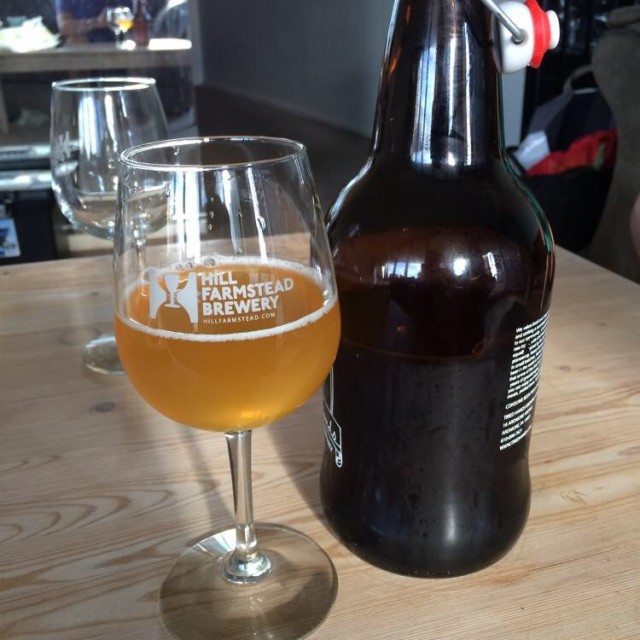With Science & Art #4 being unique as the first in the series that didn't use Citrine, this one is unique in that it is the first dark blend. It's also the beer blend that uses something other than different saisons as a sizable portion of the blend, with a Flanders-style wild being the largest component of the blend. In the end, this one ended up being 50% Flanders-style wild and 50% dark saison. The Flanders-style component is made up of two batches of Ruby (Batch 02 (recipe lost due to a computer issue, unfortunately) and Batch 03), and the saison component is made up of Demeter Rouge and Demeter Sinis (Cranberry). The final blend was as follows:
- 2 gallons of Ruby (Batch 03)
- 2 gallons of Demeter Rouge
- 0.5 gallons of Ruby (Batch 02)
- 0.5 gallons of Demeter Sinis (Cranberry)
Overall, I think this blend really captured what I was looking for, which was to take the fruitiness of Demeter Rouge, but cut back on the acidity created by the passion fruit. Oddly enough, this was accomplished by cutting the beer with a sour Flanders-style base, albeit versions of that beer that were more funky than acidic, particularly given the age of the "young" Ruby that was used. The Demeter Sinis (Cranberry) added a nice bit of cranberry alongside some earthy, spicy notes from the black cardamom and lavender used in that beer. Finally, the Ruby additions allowed some mild funk along with notes of strawberry, raspberry, and general jam character, which is something I've had in my recent dark wild beers, particularly Biere de Nord (which I actually thought about using a bit of in this blend, but determined it wasn't necessary).
In terms of process, the Demeter Rouge, Ruby (Batch 02), and Demeter Sinis (Cranberry) were all already carbonated, so I had to be careful on that front. The Demeter Rouge was carbonated to around 2.0 volumes in a keg, and the latter two had already been bottle conditioned and were probably around 2.5 and 3.0 volumes, respectively. Given this, I opted to only aim for 2.0 volumes when using the priming calculator, assuming that this would eventually get me somewhere in the 2.5-3.0 volume range.
In the future, once I hopefully open up a small brewery and have my own little barrel room, I'll be able to blend components without worrying about needing to pull from previously-bottled batches. One thing I'm planning on doing in the future to have more for blending is to take a half gallon or gallon of each batch and let it continue to age in a growler or gallon jug. That way, I can have uncarbonated beer for blending, and also add wine- or spirit-soaked oak cubes to portions of a batch for greater complexity. I've done smaller portions with oak cubes in the past, but never with the general intention of saving that beer for blending.
With that, the full tasting notes for this blend are below. Follow additional views on this beer, take a look at its page on Untappd.
Appearance: Deep mahogany with an even stronger reddish hue under bright light. Head fizzes up light brown, a bit darker and thicker than with cola. Could go for better retention and stability, though it's not too bad considering that a decent chunk of this beer is Flanders-style wild.
Aroma: Initial nose is quite fruity with cranberry and cherry leading the way. A hint of orange zest alongside faint coffee and chocolate notes. A touch of roasted malt and hints of cardamom. Lactic acidity in the back along with a touch of earthy funk. There's a general fruity, berry-jam character to it as well, which I attribute to the Ruby variations included in the blend. Strawberries and raspberries more and more as it warms. Just a hint of tropical fruit. The cranberry, of course is from the cranberry version of Demeter Sinis, and the cherry comes from the Demeter Rouge. The passion fruit in the Demeter Rouge is only there in faint tropical notes.
Flavor: The tropical character comes through plenty more in the flavor, along with more noticeable acidity. Cherry, cranberry, and jam there as well. A bit of earth and funk, though that's relatively minor. Hints of red wine.
Mouthfeel: Medium-light and moderately acidic. Carbonation moderate as well, hitting about where I wanted it to be. It's elevated over typical clean ale levels, but not nearly high enough to be at saison level. The beer is a bit light, and could use some extra body. It would have been great to have been able to put this in a red wine barrel, picking up some oak character, tannin, and body.
Overall: I'm quite happy with this blend. Other than the aforementioned lack in body, there isn't too much that I would change here. I think this one definitely accomplished the foremost blending goal of creating something more interesting and enjoyable than any individual component.











